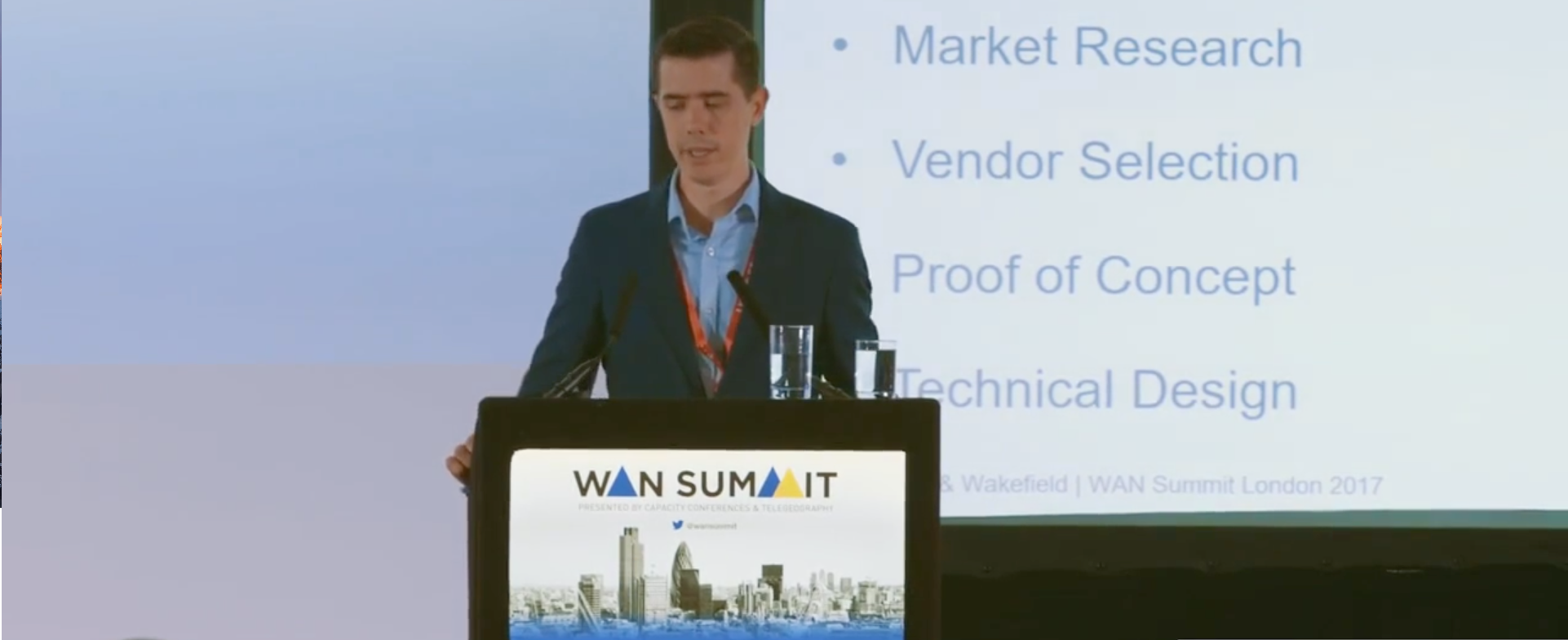Cushman & Wakefield is a 100-year-old, privately-held real estate services business. It reached its current size through a series of mergers and acquisitions–activity that meant its network was a mishmash of services from different providers.
And like so many other companies, the team at Cushman & Wakefield needed to re-engineer their network.
Global Engineer Laurence Andrews is the architect of Cushman’s recent SD-WAN implementation. At WAN Summit London, he spoke about the process and ultimate solution.
The IT department realized it needed to quickly address their inability to scale. Andrews and his team initially shifted a host of applications to the cloud—including Salesforce, Office 365, Skype for Business, Service Now, Workday, and Power BI. “The cloud meant we could use those applications very quickly and scale to the right size,” says Andrews.
There were some obvious challenges that came with integrating the mergers and acquisitions: application access, managing service providers, ensuring a consistent branch experience, network availability/performance, and real estate changes. “As a real estate company, we’re very good at moving offices very quickly, which makes for issues for us as an IT department,” says Andrews. “Ensuring that the network functions reliably is a real challenge.”
“As a real estate company, we’re very good at moving offices very quickly, which makes for issues for us as an IT department,” says Andrews. “Ensuring that the network functions reliably is a real challenge.”
It was also clear, he adds, that Cushman & Wakefield needed greater flexibility.
They needed to augment or replace MPLS. They needed visibility and control to see and control its applications and prioritize traffic types. They needed better performance and improved security. And, of course, the company needed to reduce its connectivity and equipment costs and the complexity of the network. “With the adoption of cloud and SaaS services we needed a way to ensure that staff had really good performance on those applications,” says Andrews.
Building a Business Case
The company developed a solid business case around deploying SD-WAN. In building its business case it considered:
- Solution Type: Cushman thought about whether it should deploy a product managed by the IT department, managed by a provider, or a hybrid approach.
- Implementation Approach: Should it deploy hardware to branches?
- Network Inventory: With an organization of 350-400 branches, the IT team needed full knowledge of the inventory, not just what was connected. “We spent a lot of time understanding where and how we should spend money on WAN, understanding the type of WAN we had,” says Andrews.
- Market Research: Cushman & Wakefield spent a lot of time with analyst houses and consultants to make sure it fully understood the range of WAN products and solutions available.
- Proof of Concept: The company used Silver Peak for its proof of concept work; Silver Peak provided a solution that was scalable and offered solution for its Wan acceleration products.
- Technical Design: This should not be underestimated, says Andrews, adding that the deployment of SD-WAN in an enterprise the size of Cushman & Wakefield is not straightforward.
Cushman & Wakefield also worked with TeleGeography toward the end of the development of its business case to understand how it overspent, where the service could be changed, and what it could expect from different providers. “It gave us confidence in our financial business case,” says Andrews
"We spent a long time with TeleGeography to understand what kinds of products are available, what other kinds of WAN solutions are available for us to move forward with."
After building the business case the company moved away from MPLS and opted for an internet-first model.
“It became clear that MPLS is not the future for our company, we needed to deliver the internet quickly to our branches,” says Andrews. “We get more Mbps per dollar, faster installation, service portability, local ownership of the service, all sorts of benefits.”
“It became clear that MPLS is not the future for our company, we needed to deliver the internet quickly to our branches,” says Andrews.
Lessons Learned
- The internet can be more expensive. In some Asian markets, Andrews and his team found that internet can be more expensive than MPLS.
- Some providers still push MPLS. Again in some Asian markets the adoption of DIA services is not commonplace.
- Shopping locally helps to push the price down. Cushman & Wakefield found that approaching local and regional providers helped with pricing.
- Procurement teams are essential.
- Savings are possible.
- SD-WAN gives you control. DIA gives you flexibility to use who you want, where you want—and therefore you have more control.
Implementation Can Be Fast
With 300 branches needing the technology, implementation had to be carefully managed. The IT team made use of a four-step process for implementation: assessment, deployment, optimization, and decommissioning the legacy equipment.
“We were surprised at how quickly we could deploy SD-WAN,” concludes Andrews. “We found we could deploy to 100 branches in as many days. We found you can’t rely on your local teams enough. They know their local business, local applications, they know what to test, and how to ensure things work reliably.”
Greg Bryan
Greg is Senior Manager, Enterprise Research at TeleGeography. He's spent the last decade and a half at TeleGeography developing many of our pricing products and reports about enterprise networks. He is a frequent speaker at conferences about corporate wide area networks and enterprise telecom services. He also hosts our podcast, TeleGeography Explains the Internet.


